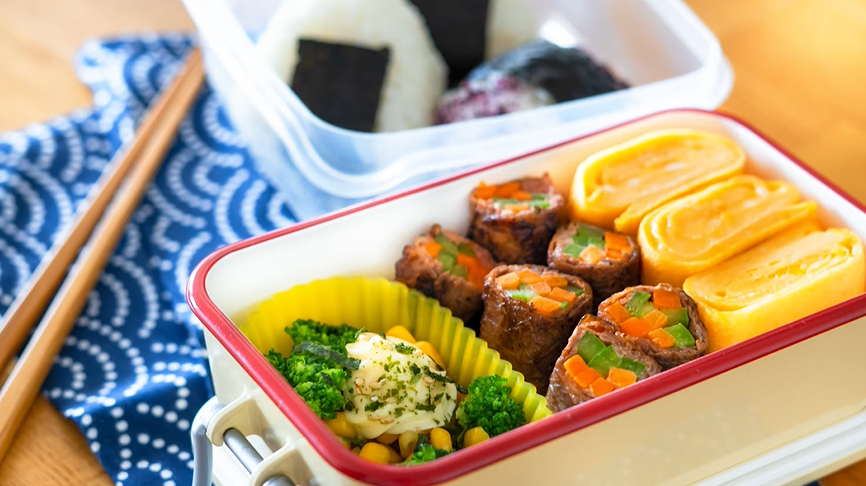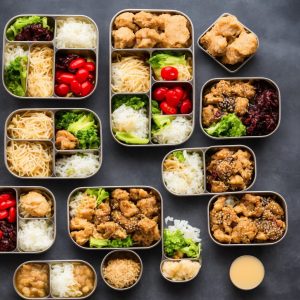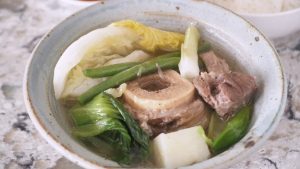Tamagoyaki bento box is a delightful Japanese lunch box, ideal for picnics or packed lunches. It incorporates several essential elements of Japanese cuisine like onigiri, tamagoyaki and seasoned vegetables. This recipe brings together the flavors of Japan in an easy-to-follow manner.

This recipe incorporates some special ingredients that may not be commonly found in your pantry. Nori is a type of seaweed used in Japanese cooking, specifically for sushi and onigiri. It's available in sheets and can be found in the international aisle of most supermarkets. Mirin is a sweet rice wine, a staple in Japanese cuisine, used for seasoning. Tamari is a type of soy sauce that's thicker, less salty and has a stronger umami flavor. Bonito flakes are thin shavings of dried, fermented, and smoked skipjack tuna. They're used in Japanese cooking for their strong umami flavor.
Ingredients for Tamagoyaki Bento Box
White rice: A short-grain variety, it is used to make the onigiri. It has a slightly sticky texture when cooked, making it easy to shape.
Nori: Seaweed sheet used for wrapping the onigiri and in tamagoyaki. It adds a salty, umami flavor.
Bonito flakes: Used for stuffing the onigiri, they give a subtle smoky flavor.
Sesame seeds: Used for garnishing the onigiri, they add a nutty flavor and crunch.
Eggs: The main ingredient of the tamagoyaki, a Japanese-style rolled omelet.
Mirin: A sweet rice wine used for seasoning the tamagoyaki.
Tamari: A variety of soy sauce, it is used for seasoning the tamagoyaki and for making a dipping sauce.
Vegetable oil: Used for cooking the tamagoyaki.
Fresh ginger: Used in the dipping sauce, it adds a fresh, zesty flavor.
Wasabi paste: Gives a spicy kick to the dipping sauce.
Broccoli florets: Adds color, texture and health benefits to the bento box.
Edamame: Shelled soybeans, they are a great source of protein and are used to add variety to the bento box.
One reader, Blancha Null says:





This tamagoyaki bento box recipe is a game-changer! The tamagoyaki was perfectly fluffy and flavorful, and the onigiri was a delightful addition. The combination of flavors and textures made for a satisfying and delicious meal. I can't wait to make it again!
Key Techniques for Tamagoyaki Bento Box Recipe
How to make onigiri: Form the cooled rice into 4 equal portions, create an indention in one of the rice portions, fill the indention with bonito flakes, top with another rice portion to close the onigiri, form into an oval shape, and wrap the middle with a strip of nori.
How to make tamagoyaki: Whisk together the eggs, mirin, and tamari, cook the egg mixture in a pan, roll the omelet carefully with nori, and cut into 4 pieces.
How to make tamari, ginger, and wasabi paste mixture: Mix 2 tablespoons of tamari, ginger, and wasabi paste together in a bowl.
How to assemble bento box: Place the onigiri, tamagoyaki, tamari, ginger, and wasabi paste mixture, steamed broccoli, and edamame into the bento box.
How To Make Tamagoyaki Bento Box
Make lunch fun and delicious with this traditional Japanese tamagoyaki bento box. You can form the onigiri into cute shapes or animal figures.
Serves:
Ingredients
For the Onigiri:
- ½cupshort-grain white rice,uncooked
- ¾cupwater
- 1sheet nori,dry seaweed or as needed
- 2tspbonito flakes,divided
- 1tspwhite sesame seeds
- 1tspblack sesame seeds
For the Tamagoyaki:
- 2large eggs
- 1tspmirin,Japanese sweet wine
- ⅛tsptamari
- 1tspvegetable oil
- 2tbsptamari
- 1tspfreshly grated ginger
- ⅛tspwasabi paste
- ¼cupbroccoli florets,steamed
- ½;
Instructions
-
Rinse rice with cool water until the water runs clear; drain. Bring rice and ¾ cup of water to a boil in a pot. Reduce heat and let simmer until water is absorbed for about 15 minutes. Let cool for about 10 to 20 minutes.
-
Cut the sheet of nori into two 1-inch strips; reserve the remainder of the sheet for making tamagoyaki.
-
Wet your hands and form the cooled rice into 4 equal portions. Keep your hands wet to keep rice from sticking. Create an indention in one of the rice portions using your thumb.
-
Fill the indention with 1 teaspoon bonito flakes. Top with another rice portion to close the onigiri. Form into an oval shape and wrap the middle with a strip of nori.
-
Make another onigiri with the remaining ingredients. Sprinkle white and black sesame seeds on top. Place in a bento box.
-
Whisk together the eggs, mirin, and ⅛ teaspoon tamari together in a bowl; divide into 3 portions. Cut the remaining portion of the nori sheet into four ½-inch strips.
-
Heat oil in a small saucepan or square tamagoyaki pan over medium-high heat. Add ⅓ of the egg mixture and cook until almost firm for 2 to 3 minutes;
-
Slide onto a plate. Add the 4 strips of nori to the pan with some space between each.
-
Cook another ⅓ of the omelet the same way but roll it up carefully in the saucepan with the nori. Slide the rolled-up omelet onto the edge of the first omelet.
-
Cook the third omelet and roll it up, sliding it on top of the second omelet. Let cool enough to touch for about 5 minutes.
-
Roll the entire layered omelet together with nori inside. Cut into 4 pieces. Place into the bento box alongside the onigiri.
-
Mix 2 tablespoons of tamari, ginger, and wasabi paste together in a bowl. Put the mixture into a portable container then put it inside the bento box. Add the steamed broccoli and edamame.
Nutrition
- Calories: 702.13kcal
- Fat: 21.95g
- Saturated Fat: 4.52g
- Trans Fat: 0.08g
- Monounsaturated Fat: 9.35g
- Polyunsaturated Fat: 5.90g
- Carbohydrates: 90.97g
- Fiber: 5.11g
- Sugar: 2.75g
- Protein: 33.34g
- Cholesterol: 372.10mg
- Sodium: 2229.85mg
- Calcium: 196.41mg
- Potassium: 758.10mg
- Iron: 6.26mg
- Vitamin A: 193.59µg
- Vitamin C: 22.54mg
-
Helpful Technique Tip for Tamagoyaki Bento Box Recipe
When making your tamagoyaki, it's crucial to keep the heat at a medium-high level. Too high, and your eggs will brown and possibly burn before they're fully cooked. Too low, and your eggs will take too long to cook, resulting in a dry omelet. Also, remember to roll the omelet carefully to ensure it doesn't break apart. Using a square tamagoyaki pan can make this process easier, as it provides a perfect shape for your omelet. Lastly, don't forget to let your omelet cool before cutting into it. This will make it easier to handle and prevent it from falling apart.
Time-Saving Tips for Making Tamagoyaki Bento Boxes
Prepare the rice: Rinse the rice and start cooking it first, as it takes the longest time. While the rice is cooking, you can prepare the tamagoyaki and other components of the bento box.
Multi-task: While the rice is cooking, you can simultaneously prepare the tamagoyaki, onigiri, and the tamari, ginger, and wasabi mixture to save time.
Use pre-cooked ingredients: Consider using pre-cooked or leftover ingredients such as steamed broccoli and edamame to save time on preparation.
Substitute Ingredients For Tamagoyaki Bento Box Recipe
short-grain white rice - Substitute with sushi rice: Sushi rice has a similar texture and stickiness, making it a suitable substitute for short-grain white rice in onigiri.
bonito flakes - Substitute with dried shrimp flakes: Dried shrimp flakes provide a similar umami flavor and can be used as a substitute for bonito flakes in onigiri.
mirin - Substitute with sweet sherry: Sweet sherry can be used as a substitute for mirin to add a similar sweet and tangy flavor to the tamagoyaki.
tamari - Substitute with soy sauce: Soy sauce can be used as a substitute for tamari to provide a similar salty and savory flavor to the tamagoyaki.
vegetable oil - Substitute with canola oil: Canola oil can be used as a substitute for vegetable oil in cooking the tamagoyaki, as it has a neutral flavor and high smoke point.
ginger - Substitute with ground ginger: Ground ginger can be used as a substitute for freshly grated ginger in the tamagoyaki marinade, providing a similar flavor profile.
wasabi paste - Substitute with horseradish paste: Horseradish paste can be used as a substitute for wasabi paste to add a similar spicy kick to the tamagoyaki marinade.
broccoli florets - Substitute with snap peas: Snap peas can be used as a substitute for broccoli florets in the bento box, providing a similar crunch and vibrant green color.
shelled edamame - Substitute with sliced green beans: Sliced green beans can be used as a substitute for shelled edamame in the bento box, offering a similar texture and color.
Presenting Your Tamagoyaki Bento Box
Elevate the onigiri: Mold the rice into perfect oval shapes and wrap them with precisely cut nori strips. Ensure the bonito flakes are evenly distributed and the sesame seeds are sprinkled with precision.
Craft the tamagoyaki with finesse: Roll the layers of omelet and nori together, ensuring a perfect spiral pattern. Cut the tamagoyaki into precise pieces, each showcasing the layers and the nori within.
Arrange the bento box with precision: Place the onigiri and tamagoyaki in the bento box with careful attention to symmetry and balance. Ensure that the tamari, ginger, and wasabi paste are presented in a separate container, adding a pop of color to the arrangement.
Garnish with vibrant greenery: Place the steamed broccoli and edamame in the bento box, ensuring they are positioned to add a burst of color and freshness to the overall presentation.
Essential Tools for Making Tamagoyaki Bento Boxes
- Pot: A pot is used for cooking the rice and boiling the broccoli and edamame.
- Bowl: A mixing bowl is used for whisking the eggs and combining the tamari, ginger, and wasabi paste.
- Tamagoyaki pan: This special square pan is used for making the tamagoyaki omelet.
- Saucepan: A small saucepan is used for cooking the tamagoyaki omelet.
- Plate: A plate is used for cooling the tamagoyaki omelet before rolling it.
- Portable container: A portable container is used for holding the tamari, ginger, and wasabi paste mixture.
Storing and Freezing Tamagoyaki Bento Boxes
Here are the storing and freezing guidelines for the tamagoyaki bento box recipe:
- Store the tamagoyaki bento box in an airtight container in the refrigerator for up to 3 days. Keep the tamari dipping sauce in a separate container to prevent the rice and omelet from getting soggy.
- To freeze the tamagoyaki bento box:
- Wrap the onigiri tightly in plastic wrap and place them in a freezer-safe container or bag. They can be frozen for up to 1 month.
- Place the tamagoyaki in a separate freezer-safe container or bag. It can be frozen for up to 2 weeks.
- Do not freeze the broccoli, edamame, or tamari dipping sauce. These should be prepared fresh when ready to eat.
- To reheat the frozen tamagoyaki bento box:
- Remove the onigiri and tamagoyaki from the freezer and let them thaw in the refrigerator overnight.
- Microwave the onigiri for 30-60 seconds or until heated through. If desired, you can also pan-fry them in a little bit of oil to crisp up the exterior.
- Microwave the tamagoyaki for 15-30 seconds or until heated through.
- Prepare the vegetables and tamari dipping sauce fresh and assemble the bento box as desired.
How To Reheat Leftover Tamagoyaki Bento Box
To reheat leftover tamagoyaki, remove it from the bento box and place it on a microwave-safe plate. Cover the plate with a damp paper towel and microwave on high for 30-45 seconds, or until heated through. The damp paper towel will help prevent the tamagoyaki from drying out and becoming rubbery.
If you prefer a crispier texture, you can reheat the tamagoyaki in a toaster oven. Preheat the toaster oven to 350°F (175°C) and place the tamagoyaki on a small baking sheet lined with parchment paper. Bake for 3-5 minutes, or until heated through and slightly crispy on the outside.
For the onigiri, remove them from the bento box and wrap each one individually in a damp paper towel. Microwave on high for 30-45 seconds, or until heated through. The damp paper towel will help keep the rice moist and prevent it from drying out.
If you have access to a steamer, you can also reheat the onigiri using this method. Place the onigiri in a steamer basket lined with a damp cloth or parchment paper, and steam for 3-5 minutes, or until heated through.
For the broccoli and edamame, place them in a microwave-safe bowl with a tablespoon of water. Cover the bowl with a microwave-safe lid or plastic wrap, and microwave on high for 1-2 minutes, or until heated through. The steam from the water will help keep the vegetables moist and prevent them from drying out.
Alternatively, you can reheat the broccoli and edamame in a steamer basket over boiling water for 2-3 minutes, or until heated through. This method will help preserve the texture and flavor of the vegetables.
Interesting Fact About Tamagoyaki Bento Boxes
The Japanese omelet, tamagoyaki, is a traditional dish often served in bento boxes. It is made by rolling together layers of seasoned eggs to create a sweet and savory flavor. The technique of rolling the omelet is a skill that requires practice and precision, and it is often considered an art form in Japanese cuisine. The tamagoyaki is a popular choice for bento boxes due to its versatility and ability to be served at room temperature, making it a convenient and delicious addition to a packed lunch.
Is Making Tamagoyaki Bento Boxes at Home Cost-Effective?
This tamagoyaki bento box recipe is quite cost-effective for a household. The ingredients, such as eggs, rice, broccoli, and edamame, are affordable and readily available. The recipe offers a balanced combination of protein, carbohydrates, and vegetables, making it a nutritious and satisfying meal. The approximate cost for a household of 4 people would be around $10-$15, depending on the availability and pricing of the ingredients. Overall Verdict: 9.
Is Tamagoyaki Bento Box Healthy or Unhealthy?
The tamagoyaki bento box recipe is a relatively healthy option, offering a balance of carbohydrates, protein, and vegetables. The onigiri provides complex carbohydrates from the short-grain white rice, while the bonito flakes and sesame seeds add flavor and nutrients. The tamagoyaki, made with eggs and seasoned with mirin and tamari, is a good source of protein. The inclusion of broccoli and edamame further enhances the nutritional value by providing fiber, vitamins, and minerals.
However, there are a few areas where the recipe could be improved to make it even healthier:
- Consider using brown rice instead of white rice for the onigiri to increase the fiber content and provide more nutrients
- Reduce the amount of tamari used in the tamagoyaki and the dipping sauce to lower the sodium content
- Include a greater variety of vegetables, such as carrots, bell peppers, or cherry tomatoes, to add more color, texture, and nutrients to the bento box
- Opt for low-sodium tamari or soy sauce to further reduce the sodium content
- Experiment with using a mixture of whole eggs and egg whites in the tamagoyaki to lower the cholesterol content while maintaining protein levels
By making these small adjustments, the tamagoyaki bento box can become an even more nutritious and well-rounded meal that provides sustained energy throughout the day.
Editor's Opinion on Tamagoyaki Bento Box Recipe
The tamagoyaki bento box recipe is a delightful combination of traditional Japanese flavors and textures. The onigiri, with its savory bonito filling and nori wrapping, provides a satisfying base, while the tamagoyaki's layers of delicate omelet and nori add a beautiful visual and culinary contrast. The addition of steamed broccoli and edamame brings a fresh and nutritious element to the meal. The tamari, ginger, and wasabi paste mixture provides a punch of umami and heat, elevating the overall dining experience. This bento box is a well-balanced and visually appealing meal that showcases the artistry and harmony of Japanese cuisine.
Enhance Your Tamagoyaki Bento Box Recipe with These Unique Side Dishes:
Similar Recipes to Tamagoyaki Bento Box
Appetizer and Dessert Pairings for Tamagoyaki Bento Box
Why trust this Tamagoyaki Bento Box Recipe:
This recipe offers a traditional Japanese bento box experience, featuring homemade onigiri and tamagoyaki. The use of authentic ingredients such as bonito flakes and mirin ensures an authentic flavor. The step-by-step instructions and precise measurements guarantee a successful outcome. The inclusion of edamame and broccoli adds a nutritious touch, making it a well-rounded meal. The combination of tamari, ginger, and wasabi paste provides a delightful dipping sauce, elevating the overall dining experience.
Was this page helpful?
Have your own special recipe to share? Submit Your Recipe Today!














